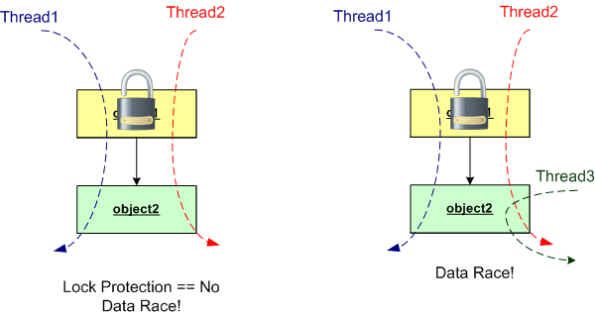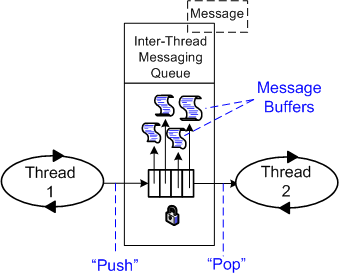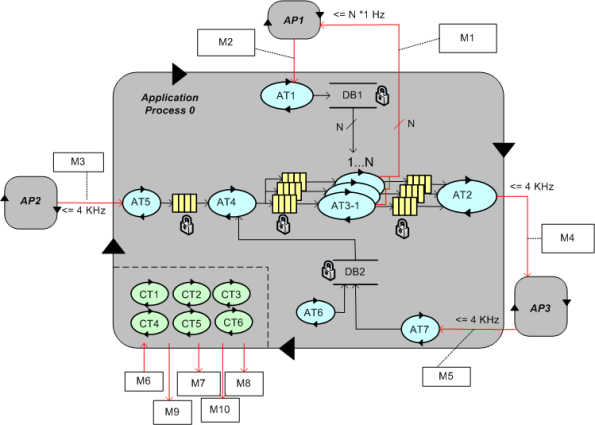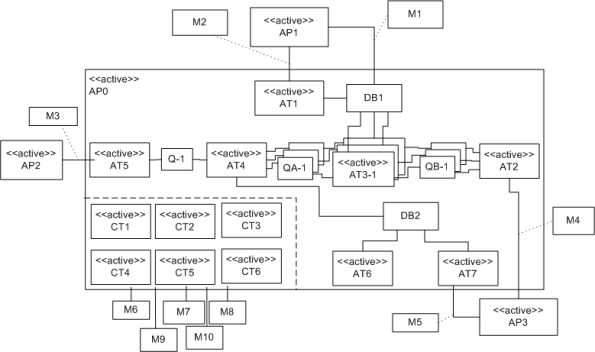Archive
Two Plus Months
Race conditions are one of the worst plagues of concurrent code: They can cause disastrous effects all the way up to undefined behavior and random code execution, yet they’re hard to discover reliably during testing, hard to reproduce when they do occur, and the icing on the cake is that we have immature and inadequate race detection and prevention tool support available today. – Herb Sutter (DrDobbs.com)
With this opening paragraph in mind, observe the figure below. If you don’t lock-protect a stateful object that’s accessed by more than one thread, you’re guaranteed to fall into the dastardly trap that Herb describes. D’oh!
Now, look at the two object figure below. Unless you protect each of the two objects in the execution path with a lock, you’re hosed!
To improve performance at the expense of higher risk, you can use one lock for the two object example like on the left side of this graphic:
Alas, if you do choose to use one lock in a two object configuration like the example above, you better be sure that you don’t come in through the side with another thread to use the thread-unsafe object2. You also better be sure that a future maintainer of your code doesn’t do the same. But wait… How can you ensure that a maintainer won’t do that? You can’t. So stick with the more conservative, lower performance, one-lock-per-object approach.
Don’t ask me why I wrote this post cuz I ain’t answering. Well, Ok, ask. I wrote this post because I was burned by the left-hand side of the second graphic in this post. It took quite awhile, actually two plus months, to finally localize and squash the bugger in production code. As usual, Herb was right.
And please, don’t tell me that lock-free programming is the answer:
…replacing locks wholesale by writing your own lock-free code is not the answer. Lock-free code has two major drawbacks. First, it’s not broadly useful for solving typical problems—lots of basic data structures, even doubly linked lists, still have no known lock-free implementations. Second, it’s hard even for experts. It’s easy to write lock-free code that appears to work, but it’s very difficult to write lock-free code that is correct and performs well. Even good magazines and refereed journals have published a substantial amount of lock-free code that was actually broken in subtle ways and needed correction. – Herb Sutter (Dr. Dobbs).
Standard, Portable C++ Concurrency
Recently, I downloaded the Microsoft Visual Studio 11 IDE Beta in order to start experimenting with some C++11 features. Lo and behold, standard and portable concurrency is now supported:
At least on Windows, there’s no need to use the Win API, Boost.Thread or ACE or any other third party library in the future to write multi-core friendly, multi-threaded C++ apps. I don’t know when GCC and/or CLANG will ship with the standard C++11 concurrency libs. Do you?
By the way, a series of quick tests verified that lambdas, strictly typed enums, auto, nullptr, std::array, std::regex, and std::atomic work. Initializer lists, raw string literals, “using” as typedef, and range-based for loops don’t work yet.
Concurrency Support
Assuming that I remain a lowly, banana-eating programmer and I don’t catch the wanna-be-uh-manager-supervisor-director-executive fever, I’m excited about the new features and library additions provided in the C++11 standard.
Specifically, I’m thrilled by the support for “dangerous” multi-threaded programming that C++11 serves up.
For more info on the what, why, and how of these features and library additions, check out Scott Meyers’ pre-book training package, Anthony Williams’ new book, and Bjarne’s C++11 FAQ page.
Persistent Discomfort
As part of the infrastructure of the distributed, multi-process, multi-threaded system that my team is developing, a parameterized, mutex protected, inter-thread message queue class has been written and dropped into a general purpose library. To unburden application component developers from having to do it, the library-based queue class manages a reusable pool of message buffers that functionally “flow” from one thread to the next.
On the “push” side of the queue, usage is as follows:
- Thread acquires a handle to the next empty Message buffer
- Thread fills Message buffer
- Thread returns handle to the queue (push)
On the “pop” side of the queue, usage is as follows:
- Thread acquires a handle to the next full Message buffer (pop)
- Thread processes the Message content
- Thread returns handle to the queue
So far, so good, right? I thought so too – at the beginning of the project. But as I’ve moved forward during the development of my application component, I’ve been experiencing a growing and persistent discomfort. D’oh!
Using the figure below, I’m gonna share the cause of my “inner thread” discomfort with you.
In order to functionally process an input message and propagate it forward, the inner thread must do the following work:
- Acquire a handle to the next input Message buffer from queue 1 (pop)
- Acquire a handle to the next empty output Message buffer from queue 2
- Utilize the content of the Message from queue 1 to compute/fill in the Message to queue 2
- Return the handle of the input message to queue 1
- Return the handle of the output message to queue 2 (push)
For small messages and/or when the messages are of different types, I don’t see much wrong with this inter-thread message passing approach. However, when the messages are big and of the same type, my discomfort surfaces. In this case (as we shall see), the “utilize” bullet amounts to an unnecessary copy. The more “inner” threads there are in the pipeline, the more performance degradation there is from unnecessary copies.
So, how can the copies be eliminated and system performance increased? One way, as the figure below shows, is to move message buffer management responsibility out of the local queue class and into a global, shared message pool class.
In this memory-less queue design, the two pipeline end point threads explicitly assume the responsibility of acquiring and releasing the Message buffer handles from the mutex protected, shared message pool. The first thread “acquires” and the last thread “releases” message buffer handles. Each inner thread, i, in the pipeline performs the following work:
- Pop the handle to the next input Message buffer from queue i-1
- Process the message
- Push the Message buffer handle to queue i
The key to avoiding unessential inner thread copies is that the messages must be intentionally designed to be of the same type.
As soon as I get some schedule breathing room (which may be never), I’m gonna refactor my application infrastructure design and rewrite the code to implement the memoryless queue + global message pool approach. That is, unless someone points out a fatal flaw in my reasoning and/or presents a superior inter-thread message communication pattern.
DataLoggerThread
The figure below models a program in which a pipeline of worker threads communicate with each other via message passing. The accordion thingies ‘tween the threads are message queues that keep the threads loosely coupled and prevent message bursts from overwhelming downstream threads.
During the process of writing one of these multi-threaded programs to handle bursty, high rate, message streams, I needed a way to periodically extract state information from each thread so that I could “see” and evaluate what the hell was happening inside the system during runtime. Thus, I wrote a generic “Data Logger” thread and added periodic state reporting functionality to each worker thread to round out the system:
Because the reporting frequency is low (it’s configurable for each worker thread and the default value is once every 5 seconds) and the state report messages are small, I didn’t feel the need to provide a queue per worker thread – YAGNI.
The figure below shows a more detailed design model of the data logging facility in the form of a “bent” UML class diagram. Upon construction, each DataLoggerThread object can be configured to output state messages to a user named disk file and/or the global console during runtime. The rate at which a DataLoggerThread object “pops” state report messages from its input queue is also configurable.
The DataLoggerThread class provides two different methods of access to user code at runtime:
void DataLoggerThread::record_txt_block(const Data&)
and
void DataLoggerThread::operator<<(const Data&).
Objects of the DataLoggerThread class run in their own thread of execution – transparently in the background to mainline user code. On construction, each object instance creates a mutex-protected, inter-thread queue and auto-starts its own thread of operation behind the scenes. On destruction, the object gracefully self-terminates. During runtime, each DataLoggerThread object polls its input queue and formats/writes the queue entries to the global console (which is protected from simultaneous, multiple thread access by a previously developed CoutMonitor class) and/or to a user-named disk log file. The queue is drained of all entries on each (configurable,) periodic activation by the underlying (Boost) threads library.
DataLoggerThread objects pre-pend a “milliseconds since midnight” timestamp to each log entry just prior to being pushed onto the queue and a date-time stamp is pre-pended to each user supplied filespec so that file access collisions don’t occur between multiple instances of the class.
That’s all I’m gonna disclose for now, but that’s OK because every programmer who writes soft, real-time, multi-threaded code has their own homegrown contraption, no?
SysML, UML, MML
I really like the SysML and UML for modeling and reasoning about complex, multi-technology and software-centric systems respectively, but I think they have one glaring shortcoming. They aren’t very good at modeling distributed, multi-process, multi-threaded systems. Why? Because every major element (except for a use case?) is represented as a rectangle. As far as I know, a process can be modeled as either a parallelogram or a stereotyped rectangular UML class (SysML block ):
To better communicate an understanding of multi-threaded, multi-process systems, I’ve created my own graphical “proprietary” (a.k.a. homegrown) symbology. I call it the MML (UML profile). Here is the MML symbol set.
An example MML diagram of a design that I’m working on is shown below. The app-specific modeling element names have been given un-descriptive names like ATx, APx, DBx, Mx for obvious reasons.
Compare this model with the equivalent rectangular UML diagram below. I purposely didn’t use color and made sure it was bland so that you’d answer the following question the way I want you to. Which do you think is more expressive and makes for a better communication and reasoning tool?
If you said “the UML diagram is better“, that’s OK. 🙂

















